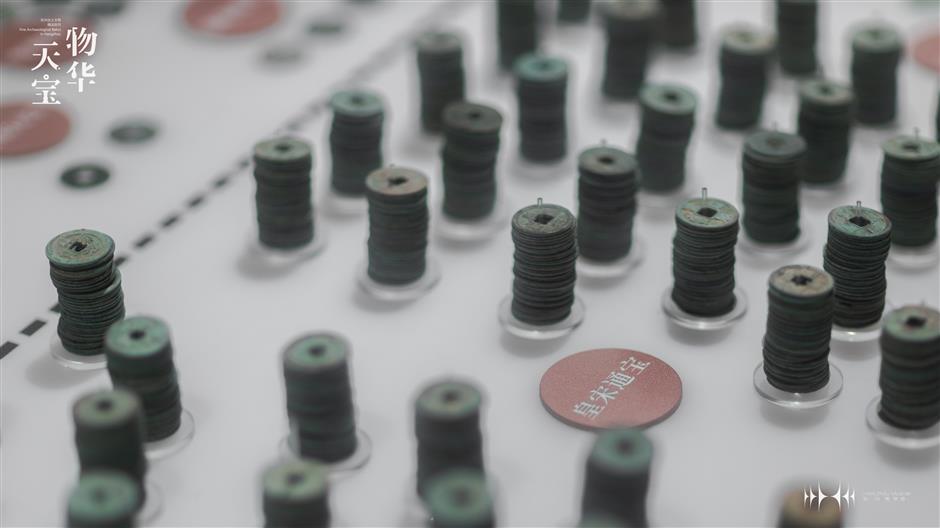Archaeological relics hall unveiled at Hangzhou Museum
After months of preparation, the Archeological Relics of Hangzhou Exhibition Hall officially lifted the veil at Hangzhou Museum on September 6.
The exhibition hall, which houses over 130 artifacts dating from the Neolithic period to the Republic of China (1912-1949), is an ideal venue to learn more about the city's and adjacent counties' important archaeological discoveries.
"We upgraded the ventilation facilities and other infrastructure in efforts to preserve collections and give visitors a better experience," said Wang Yingxiang, director of the museum.
The antiques are divided into three categories: Neolithic Civilization, Yuan Dynasty (1271–1368) porcelain, Ming Dynasty (1368–1644) coins and the Qiantang River seawall.
The relics were all discovered within the last 100 years. Each category highlights the city's historical and cultural veins.

The exhibition displays the main seawalls in Hangzhou constructed during the Wuyue Kingdom (AD 907-978).
Shanghai Daily spotchecked several highlights that reflect the wisdom and resourcefulness of the ancient Hangzhou people.
Eleven national treasures have been shown in the city for the first time. One of the centerpieces is an 8,000-year-old wooden oar from the Kuahu Bridge Neolithic Site.
The excavation of the Kuahu Bridge site in the city's south took more than 12 years and resulted in numerous significant archaeological discoveries. A canoe and oars recovered at the site are thought to be the country's earliest ever to be uncovered. Grains discovered there suggest that rice was harvested 1,000 years earlier than previously assumed.
Growing paddies, fishing and hunting provided a living for people who lived in present-day Kuahu Bridge. The displayed wooden oar, classified as a top-level treasure in China, could testify to ancient people's lifestyle in the crisscrossed watercourse area.
In ancient times, people excavated underground caves that served as lockers to store their treasures. However, due to wars and turbulence, several caves had been forgotten. They were discovered during urban construction after being buried for centuries.

An 8,000-year-old wooden oar from the Kuahu Bridge Neolithic Site
When a firm on Zhaohui Road refurnished its complex in 1987, 54 pieces of refined Yuan Dynasty porcelain were unearthed. One of these objects, a top-tier national antique, is on display in the renovated exhibition hall.
It's a grayish-green glazed celadon item with twisting vines and peonies carved on it. Such a large celadon, measuring 68.5 centimeters in height and 29 centimeters in diameter, was uncommon at the time.
Ancient Zhejiang craftsmen used techniques from the ceramic industries of northern and southern China to create many colors of green glaze, which they dubbed celadon.
As the exhibit reveals, they changed the clay composition and glazing procedures to create whitish-green and pinky-green variations. The graceful shape and jade-like texture were the pinnacle of celadon techniques.
Another cave was discovered in Jiangcun Subdistrict in 2010. Archaeologists were called in immediately. Excavated coins from the Han (206 BC–AD 220) to Ming dynasties have provided historians with valuable materials for investigating ancient currency history.
Organizers have already sorted the nearly 6,000 coins discovered there and arranged them chronologically.

Coins discovered in a cave in Jiangcun Subdistrict are sorted and arranged chronologically in a display cabinet.
Historically, the Qiantang River's tidal bores caused recurrent flooding in the city. The residents of Hangzhou battled the raging waves and eventually built their own "great wall" between the water and the city.
The Wuyue Kingdom (AD 907-978) was responsible for designing the seawalls and old Hangzhou. The exhibition displays the main seawalls constructed during the Five Dynasties and Ten Kingdoms period (AD 907-979) in Wuyue Kingdom.
It was constructed using an old technique called saogong (埽工), which involved large cages woven with bamboo strips and loaded with stones. These are stacked layer by layer, with grass and wood added on top for extra strength.
Hangzhou swiftly became a thriving trading center as a result of these groundbreaking seawalls. These seawalls existed until the Song Dynasty (960–1279). This discovery has advanced our understanding of Chinese building techniques by one century earlier than was previously assumed.
If you go:
Hours: 9am-4:30pm (closed on Tuesdays)
Admission: Free
Venue: Hangzhou Museum
Address: 18 Liangdao Hill
粮道山18
















